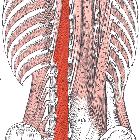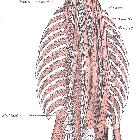Musculi multifidi


The transversospinalis group is the deep layer of the intrinsic back muscles. These muscles lie between the transverse and spinous processes and are grouped by length of the fascicles, as well as region covered. The groups are rotatores, multifidus, and semispinalis.
Gross anatomy
Rotatores
The rotatores are the deepest muscles in the transversospinalis group and have the shortest fascicles, spanning one to two segments. The muscles in this group are the rotatores capitis, rotatores cervicis, and rotatores thoracis. The rotatores thoracis is the most developed in this group. The cervical-level and lumbar-level rotatores are not obviously present and may be represented by deeper fascicles of the multifidus .
- rotatores thoracis
- eleven pairs of small quadrilateral muscles, each segment containing a rotator brevis and rotator longus
- first pair is between T1 and T2, and the last is between T11 and T12. The first or last pair can sometimes be absent.
- rotator brevis
- origin: the upper, posterior part of the inferior transverse process
- insertion: lower border and lateral surface of the superior lamina
- rotator longus
- origin: inferior transverse process
- insertion: base of the superior spinous process two levels above
Multifidus
The multifidus extends from the cervical to the sacral levels, lying lateral to the spinous processes and covering the laminae of the underlying vertebrae from cervical to upper lumbar levels, then expanding to encompass the sacrum at the lumbosacral levels. The fascicles span two to five segments.
- origin: posterior sacrum, posterior superior iliac spine, aponeurosis of the erector spinae, sacroiliac ligament, mammillary processes of the lumbar vertebrae, transverse processes of T1-3, articular processes of C4-C7
- insertion: fibers pass upwards and medially to insert along the length of the spinous process
Semispinalis
The semispinalis have the longest fascicles of transversospinalis group, spanning six segments. The muscles in this group are the semispinalis capitis, semispinalis cervicis, and the semispinalis thoracis.
- semispinalis capitis
- lies superficial to the semispinalis cervicis and deep to the splenius capitis and cervicis and trapezius; sometimes a small portion of the muscle remains exposed as part of the posterior triangle of the neck
- from a thickened muscle group suboccipitally, the individual fascicles pass inferiorly, laterally, and ventrally and end as flat tendons
- the biventer cervicis, formed from thoracic fascicles and named due to being crossed by an incomplete tendinous structure, is the medial part of the muscle in the cervical region
- origin: there is variation between texts but in general, the semispinalis capitis starts from superior articular processes C4 or C5 to C7 and the tips of the transverse processes of C7 or T1 to T6 or T7
- insertion: medial part between superior and inferior nuchal lines of the occiput
- semispinalis cervicis
- fascicles cover the cervical and thoracic multifidus.
- origin: T1-T5 or T6 transverse processes
- insertion: spinous process of C2-C5
- semispinalis thoracis
- thin, fleshy fascicles with long tendons at either end; covers the thoracic multifidus
- origin: T6-T10 transverse processes
- insertion: C6-T4 spinous processes
Relations
- generally, the transversospinalis group lies medial to the erector spinae
- deep to the splenius at cervical levels
- deep to the spinalis thoracis at thoracic levels
- deep to the erector spinae aponeurosis at lumbar levels
Blood supply
- dorsal branches of the posterior intercostal and lumbar arteries
Innervation
- rotatores, multifidus, semispinalis thoracis and cervicis: medial branches of dorsal rami of associated spinal nerves
- semispinalis capitis: descending branch of the greater occipital nerve (C2) and the C3 spinal nerve
Actions
- all of the transversospinalis muscles are extensors of the back and neck
- rotatores are identified as rotators in many texts , but this action has not been validated and the rotatores are more likely stabilizers of the spinal column
- the multifidus and semispinalis group has also been identified as rotators by some texts and refuted in others
Siehe auch:

 Assoziationen und Differentialdiagnosen zu transversospinale Muskelgruppen:
Assoziationen und Differentialdiagnosen zu transversospinale Muskelgruppen:
